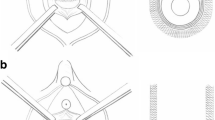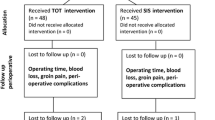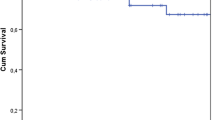Abstract
Purpose
The suburethral sling procedure has been widely used as the first-line treatment for female stress urinary incontinence (SUI). This study retrospectively compared the long-term surgical outcomes and complications between retropubic and transobturator suburethral sling procedures.
Methods
From 2010 to 2022, a total of 533 women with SUI underwent retropubic pubovaginal sling (PVS) or transobturator tape (TOT) procedures using a synthetic polypropylene mesh with or without concomitant anterior colporrhaphy. All patients underwent preoperative videourodynamic studies, Valsalva leak point pressure (VLPP), and voiding efficiency (VE). The success rate, postoperative complications, overactive bladder symptoms, transvaginal urethrolysis, and repeat procedures were compared among different surgical procedures.
Results
Among the patients, PVS was performed in 251 (47.1%) patients and with colporrhaphy in 58 (10.9%), TOT in 174 (32.6%) and with colporrhaphy in 50 (9.4%). The success rate was 87.4% in the PVS group and 75.4% in the TOT group, with or without colporrhaphy (p = 0.001). Urethrolysis was performed in 4.7% of the patients, and repeat suburethral sling procedures were performed in 8.3%. The overall success rate was significantly lower in TOT group, either with high or low VLPP, or with high or low VE. The rate of persistent OAB was significantly higher in TOT group regardless of VLPP or VE, whereas patients with VE < 90% at baseline had a significantly higher rate of postoperative dysuria.
Conclusion
TOT procedures had an inferior long-term success rate than PVS procedures for female SUI. Additionally, no differences in the success rate were observed between patients with different bladder functions, high or low VLPP, and high or low VE.


Similar content being viewed by others
Data availability
The data of this study can be obtained after contacting the corresponmding authors aftert approval of the IRB of the institution.
References
Kobashi KC, Vasavada S, Bloschichak A, Hermanson L, Kaczmarek J, Kim SK, Kirkby E, Malik R (2023) Updates to surgical treatment of female stress urinary incontinence (SUI): AUA/SUFU guideline. J Urol 209:1091–1098
Rechberger E, Wróbel A, Kulik-Rechberger B, Miotla P, Ziętek A, Rechberger T (2023) The clinical efficacy and safety of outside-in transobturator sling with additional paraurethral fixation—the prospective longitudinal study. Eur J Obstet Gynecol Reprod Biol 290:22–26
Kuo HC (2001) Comparison of video urodynamic results after the pubovaginal sling procedure using rectus fascia and polypropylene mesh for stress urinary incontinence. J Urol 165:163–168
Ong HL, Kuo HC (2019) Bladder dysfunction does not affect long-term success rate of the retropubic suburethral sling procedure in women with stress urinary incontinence. Low Urin Tract Symptoms 11:O168–O173
Liu HH, Kuo HC (2019) Durability of retropubic suburethral sling procedure and predictors for successful treatment outcome in women with stress urinary incontinence. Urology 131:83–88
Chmaj-Wierzchowska K, Raba G, Dykczyński P, Wilczak M, Turlakiewicz K, Latańska I, Sujka W (2022) Clinical outcomes of mid-urethral sling (MUS) procedures for the treatment of female urinary incontinence: a multicenter study. J Clin Med 11:6656
Farag F, Osman NI, Pang KH, Castro-Diaz D, Chapple CR, Cruz F, Gamé X, Goldman H, Greenwell T, Hampel C, Scailteux LM, Roovers JP, Welk B, Heesakkers J (2023) Complications of synthetic midurethral slings: is there a relevant discrepancy between observational data and clinical trials? Eur Urol Focus S2405-4569(23):00244–00254
O’Leary BD, McCreery A, Redmond AE, Keane DP (2023) The efficacy and complications of retropubic tension-free vaginal tapes after 20 years: a prospective observational study. BJOG 130:107–113
Padoa A, Levy E, Fligelman T, Tomashev-Dinkovich R, Tsviban A, Serati M (2023) Predictors of persistent overactive bladder following surgery for advanced pelvic organ prolapse. Int Urogynecol J 34:759–767
Six JC, Pinsard M, Guerin S, Gasmi A, Coiffic J, Richard C, Haudebert C, Nyangoh Timoh K, Hascoet J, Peyronnet B (2023) Risk factors for stress urinary incontinence recurrence after midurethral sling revision. Int J Urol 30:1008–1013
Ozkurkcugil C, Avci IE (2023) Factors predicting treatment success in mixed urinary incontinence treated with midurethral sling. Low Urin Tract Symptoms 15:50–56
Lee PJ, Kuo HC (2023) Low detrusor contractility has a less favorable outcome of anti-incontinence surgery for women with stress urinary incontinence. Int Urol Nephrol 55:2789–2798
Wu SY, Kuo HC (2019) Long-term outcomes of anti-incontinence surgery and subsequent transvaginal sling incision for urethral obstruction. Int Urogynecol J 30:761–766
Rosier PFWM, Gammie A, Valdevenito JP, Speich J, Smith P, Sinha S, Members of the ICS working group PFS23 (2023) ICS-SUFU standard: theory, terms, and recommendations for pressure-flow studies performance, analysis, and reporting .Part 2: analysis of PFS, reporting and diagnosis. Neurourol Urodyn 42(7):1603–1627
Kuo HC (2001) Anatomical and functional results of pubovaginal sling procedure using polypropylene mesh for the treatment of stress urinary incontinence. J Urol 166:152–157
Ahmed AA, Abdellatif AH, El-Helaly HA, Tagreda IA, El-Feky MM, Agha MM, Abdelraouf AG, Abdelrahim AF (2020) Concomitant transobturator tape and anterior colporrhaphy versus transobturator subvesical mesh for cystocele-associated stress urinary incontinence. Int Urogynecol J 31:1633–1640
Ong HL, Jiang YH, Kuo HC (2019) Repeat retropubic suburethral sling procedure is effective for recurrent female stress urinary incontinence. Low Urin Tract Symptoms 11:O89–O92
Kuo HC (2005) Long-term surgical results of pubovaginal sling procedure using polypropylene mesh in the treatment of stress urinary incontinence. Urol Int 74:147–152
Goessens EMV, Cammu H (2023) A 10- to 20-year follow-up after tension-free vaginal tape for stress urinary incontinence. Int Urogynecol J 34:2107–2114
Zilberlicht A, Karmakar D, DwyeR PL, Murray C, Kugelman N (2023) Predictors of surgical failure of open burch colposuspension versus retropubic midurethral sling for stress urinary incontinence. Urology 177:69–73
Solhaug BR, Nyhus MØ, Svenningsen R, Vølloyhaug I (2023) Rates of subjective and objective cure, satisfaction, and pain 10-20 years after tension free vaginal tape (TVT) surgery: a retrospective cohort study. BJOG. https://doi.org/10.1111/1471-0528.17738
Salo H, Sova H, Laru J, Talvensaari-Mattila A, Nyyssönen V, Santala M, Piltonen T, Koivurova S, Rossi H-R (2023) Long-term results of a prospective randomized trial comparing tension-free vaginal tape versus transobturator tape in stress urinary incontinence. Int Urogynecol J 34:2249–2256
Alexandridis V, Lundmark Drca A, Ek M, Westergren Söderberg M, Andrada Hamer M, Teleman P (2023) Retropubic slings are more efficient than transobturator at 10-year follow-up: a swedish register-based study. Int Urogynecol J 34:1307–1315
Kuo HC (2007) Effect of detrusor function on the therapeutic outcome of a suburethral sling procedure using a polypropylene sling for stress urinary incontinence in women. Scand J Urol Nephrol 41:138–143
Chen YC, Chen HW, Kuo HC (2023) Bladder neck incompetence could be an etiology of overactive bladder syndrome in women with stress urinary incontinence after anti-incontinence surgery: insights from transrectal sonography. World J Urol 41:3083–3089
Jiang YH, Wang CC, Chuang FC, Ke QS, Kuo HC (2013) Positioning of a suburethral sling at the bladder neck is associated with a higher recurrence rate of stress urinary incontinence. J Ultrasound Med 32:239–245
Chai TC, Huang L, Kenton K, Richter HE, Baker J, Kraus S, Litman H (2012) Urinary incontinence treatment network (UITN) association of baseline urodynamic measures of urethral function with clinical, demographic and other urodynamic variables in women prior to undergoing midurethral sling surgery. Neurourol Urodyn 31:496–501
Serna-Gallegos T, Dutta S, Crowder C, Wadensweiler P, Whitcomb EL, Guaderrama NM (2024) Risk factors for de novo overactive bladder after midurethral sling. Urogynecol (Phila) 30:59–64
Ross J, Avvakoumova L, Yassein A, Payne M, Maciejewski C, Mallick R, Breau RH, Vigil H, Hickling D (2023) Prevalence and predictors of bladder outlet obstruction in women with chronic urinary symptoms and a history of urethral sling surgery. J Urol 209(2):384–390
Morán Pascual E, Zabalo A, Colet Guitert O, Bonillo MÁ, Martínez-Cuenca E, Broseta Rico E, Budía A, Arlandis S (2023) Is detrusor underactivity associated with voiding dysfunction after single incision sling surgery? Minerva Urol Nephrol 75:642–648
Juhl C, Thimm MH, Glavind K (2023) Impact on urinary incontinence after management of complications related to a retropubic midurethral sling. Int Urogynecol J 34:2767–2774
Funding
This study was supported by the grant from Tzu Chi Medical Foundation, grant number TCMF-MP 110-03-01 and TCMF-SP 112-01.
Author information
Authors and Affiliations
Contributions
Yuan-Hong Jiang and Shenf-Fu Chen collect data and investigations Yuan-Hong Jiang wrote the draft manuscript Hann-Chorng Kuo supervised the study and revised the manuscript
Corresponding author
Ethics declarations
Competing interests
The authors declare no competing interests.
Additional information
Publisher's Note
Springer Nature remains neutral with regard to jurisdictional claims in published maps and institutional affiliations.
Rights and permissions
Springer Nature or its licensor (e.g. a society or other partner) holds exclusive rights to this article under a publishing agreement with the author(s) or other rightsholder(s); author self-archiving of the accepted manuscript version of this article is solely governed by the terms of such publishing agreement and applicable law.
About this article
Cite this article
Jiang, YH., Chen, SF. & Kuo, HC. Effect of lower urinary tract conditions on surgical outcomes of different suburethral sling procedures for female stress urinary incontinence. Int Urol Nephrol (2024). https://doi.org/10.1007/s11255-024-04047-z
Received:
Accepted:
Published:
DOI: https://doi.org/10.1007/s11255-024-04047-z




